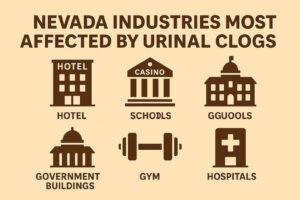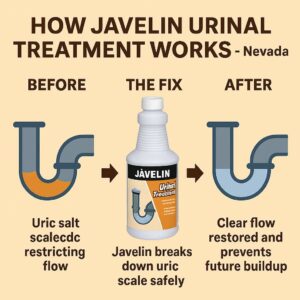If you manage a facility in Nevada – hotel, casino, school, hospital, or a municipal building, you’ve probably seen the same pattern: urinals that slow drain or clog far sooner than they should. You’re not imagining it. Nevada’s mix of very hard water, dry desert air, and high restroom traffic makes clogs show up faster here than in most states.
Here’s why it happens,, and how to stay ahead of it without waiting on a plumber.
Nevada’s Hard Water Works Against You
 Nevada’s water is loaded with calcium and magnesium. When that mineral-rich water mixes with urine, it forms uric salt scale a rock-hard deposit that sticks to the inside of drain lines.
Nevada’s water is loaded with calcium and magnesium. When that mineral-rich water mixes with urine, it forms uric salt scale a rock-hard deposit that sticks to the inside of drain lines.
Each flush adds a little more. Over time the line narrows like it’s coated in concrete flow slows, odor appears, and a urinal that looks fine on the outside ends up blocked underneath.
Background reading: USGS: Hardness of water
The Desert Air Makes Urinal Clogs Worse
Nevada’s low humidity means water in traps and lines evaporates faster. Every bit that evaporates leaves behind more minerals and uric salts. Multiply that by hundreds or thousands of uses per week especially in 24-hour facilities and buildup forms fast.
Even brand-new systems in Las Vegas or Reno can see scale forming within months.
Who’s Hit the Hardest
The same pattern shows up across most high-traffic facilities in Nevada:
- 🏨 Hotels & Casinos: 24/7 use means no downtime buildup outpaces routine cleaning.
- 🏫 Schools & Colleges: Heavy daytime use, then summer shutdowns where water sits and salts crystalize.
- 🏛️ Government & Municipal Buildings: Older plumbing plus hard water = predictable scaling.
- 🏥 Hospitals & Healthcare: Any backup is unacceptable constant, reliable flow is mandatory.
- 🏭 Manufacturing & Warehousing: Heat accelerates evaporation inside lines.
- 🏋️ Gyms, Restaurants & Bars: High daily use; typical cleaners don’t dissolve uric salts.
- ⛪ Churches & Community Centers: Infrequent use allows salts to dry and harden.
Same root cause, different buildings it adds up quickly.
The Hidden Cost of a Clogged Urinal in Nevada
 A clogged urinal isn’t just a maintenance headache it hits the budget:
A clogged urinal isn’t just a maintenance headache it hits the budget:
- Emergency plumber visits: $200–$300 per call.
- Downtime and odor complaints hurt guest experience and sanitation scores.
- Repeated blockages can lead to pipe replacement, which is a major expense.
In many cases, you’re paying a plumber to apply a chemical fix you could do yourself cheaper, faster, and safer.
The Smarter Fix: Javelin Urinal Treatment
Javelin Urinal Treatment is a professional-grade chemical that dissolves uric salt buildup safely inside the line—no heat, no fumes, no harsh acids.
- Works fast on slow or fully clogged urinals
- Safe on all common plumbing materials
- No smoke, no strong odor, no residue
- Used by Nevada facilities from schools and hospitals to hotels and casinos
Most facilities see results within hours. Put it on a monthly maintenance schedule to stay ahead of scale for good.
Final Thought
Nevada’s water and weather make urinal clogs a fact of life but they don’t have to stay that way. If your facility deals with constant backups, you’re fighting the environment itself. Javelin lets you treat the cause, not just the symptom, and keep restrooms flowing without waiting on a plumber.
👉 Learn more about Javelin Urinal Treatment
Related reading
FAQ
Why do urinals clog faster in Nevada?
Very hard water plus dry desert air causes uric salts and minerals to crystalize faster inside P-traps and lines, shrinking flow over time.
How often should we treat urinals to prevent clogs?
Most facilities stay ahead of scale with a monthly treatment schedule; high-traffic sites may treat bi-weekly.
Is this safe for our plumbing?
Yes. Javelin is designed to dissolve uric salts safely and is compatible with common plumbing materials when used as directed.
